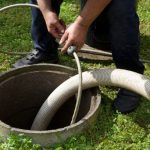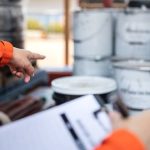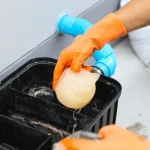The Importance of Oily Water Trap Cleaning, Maintenance, and Oily Water Disposal
For industrial and commercial facilities that handle oils, coolants, and other hydrocarbons, oily water traps (OWTs) are an essential environmental line of defence. These traps prevent pollutants from entering our waterways and causing significant damage, and they require specialised cleaning and disposal procedures due to the potential presence of hazardous materials.
Understanding Industrial Oily Water Traps
Industrial oily water traps cater to the specific needs of industrial wastewater, and here is a breakdown of their function:
1. Wastewater Influent: Industrial wastewater containing oils, coolants, and other hydrocarbons enters the trap.
2. Gravity Separation: Due to their lower density, oils and hydrocarbons rise to the surface of the trap.
3. Hydrocarbon Layer Formation: Over time, a layer of these pollutants accumulates on the trap’s surface.
4. Solids Settling: Meanwhile, heavier solids like metal shavings or machining waste settle at the bottom of the trap.
5. Treated Wastewater Effluent: The remaining, relatively hydrocarbon-free wastewater exits the trap and flows into a designated treatment system or the municipal sewer system, depending on local regulations and the specific contaminants involved.
The Importance of Oily Water Trap Maintenance in Industrial Settings
Regular cleaning and maintenance of industrial OWTs are crucial for several reasons:
- Prevents Environmental Contamination: An overflowing or malfunctioning trap can release harmful pollutants into the environment, causing damage to aquatic ecosystems and posing health risks.
- Ensures Compliance with Regulations: Industrial facilities are subject to strict environmental regulations regarding wastewater discharge, and proper OWT maintenance is often mandatory to meet these regulations.
- Maintains Optimal Treatment Efficiency: Regular cleaning ensures the trap functions effectively, maximising separation of pollutants and minimising the strain on downstream treatment systems.
- Prevents Costly Downtime: Untreated wastewater backups can disrupt operations and lead to costly downtime.
Maintaining Your Industrial Oily Water Trap
The cleaning frequency for an industrial OWT depends on the volume and type of pollutants it handles. High-volume facilities might require cleaning weekly or even daily, while others may need it on a monthly basis. Here’s a basic guide for maintaining your industrial OWT:
1. Develop a Cleaning Schedule: Consult with a licensed waste disposal company like Clarence Valley Septics to establish a cleaning schedule based on your specific needs and wastewater characteristics.
2. Regular Inspections: Schedule regular inspections to monitor the trap’s performance and identify any potential issues like leaks or blockages.
3. Professional Cleaning Services: Partner with a licensed waste disposal company like us for thorough cleaning and proper disposal of the collected hydrocarbons and solids. We have the expertise and equipment to handle hazardous materials safely and efficiently.
The Role of Spill Prevention
Beyond routine maintenance, preventing spills in the first place is paramount. Implementing spill prevention strategies like using drip pans under machinery, conducting regular equipment inspections, and training staff on proper handling procedures can significantly reduce the amount of hydrocarbons entering the OWT and minimise the frequency of cleaning required.
Responsible Disposal of Industrial Oily Water Trap Waste
The collected materials from your industrial OWT cannot be simply thrown away, as they require specialised disposal to ensure proper treatment and prevent environmental contamination. Here are some responsible disposal options:
- Licensed Waste Disposal Companies: Partner with a licensed company like Clarence Valley Septics who specialises in the collection and disposal of industrial wastewater oils. We ensure the materials are treated or recycled in an environmentally responsible manner, through processes like re-refining into reusable lubricants.
- On-Site Treatment Systems: Some industrial facilities might have on-site treatment systems to process the collected hydrocarbons before discharge into the municipal sewer system. This requires specific permits and ongoing monitoring to comply with regulations.
Additional Tips
- Invest in a well-sized oily water trap designed for the specific types and volumes of hydrocarbons your facility generates.
- Train your staff on proper wastewater management practices, including minimising the introduction of pollutants into the drains and proper spill response procedures.
- Consider installing an automatic monitoring system to track trap performance, hydrocarbon levels, and optimise cleaning schedules.
By taking a proactive approach to industrial oily water trap management, facilities can contribute significantly to a cleaner and healthier environment for all.
Choosing the Right Disposal Partner
Selecting a reputable and licensed waste disposal company like Clarence Valley Septics is crucial for responsible OWT waste management. We:
- Hold the appropriate licenses and permits for handling industrial waste.
- Offer a range of disposal options to accommodate the specific types of hydrocarbons you generate.
- Provide detailed documentation on the treatment or recycling processes used for the collected waste.
- Prioritise safety and environmental responsibility throughout the disposal process.
By partnering with a qualified waste disposal company like us, industrial facilities can ensure their OWT waste is handled safely, legally, and in an environmentally sound manner. This collaborative approach safeguards our environment and promotes a sustainable future for all.
A Partnership for Environmental Protection
Industrial oily water traps play a vital role in safeguarding our environment from harmful industrial pollutants. By prioritising regular cleaning, maintenance, and responsible disposal of the collected materials, industrial facilities can minimise their environmental footprint and ensure compliance with regulations. Working alongside a licensed waste disposal company like Clarence Valley Septics is crucial for this process, ensuring the safe and responsible handling of these potentially hazardous materials.
To arrange cleaning or maintenance of your oily water trap, or collection and disposal of the materials that it contains, please give us a call on +61 2 6645 3100 or send us a message via our website.


